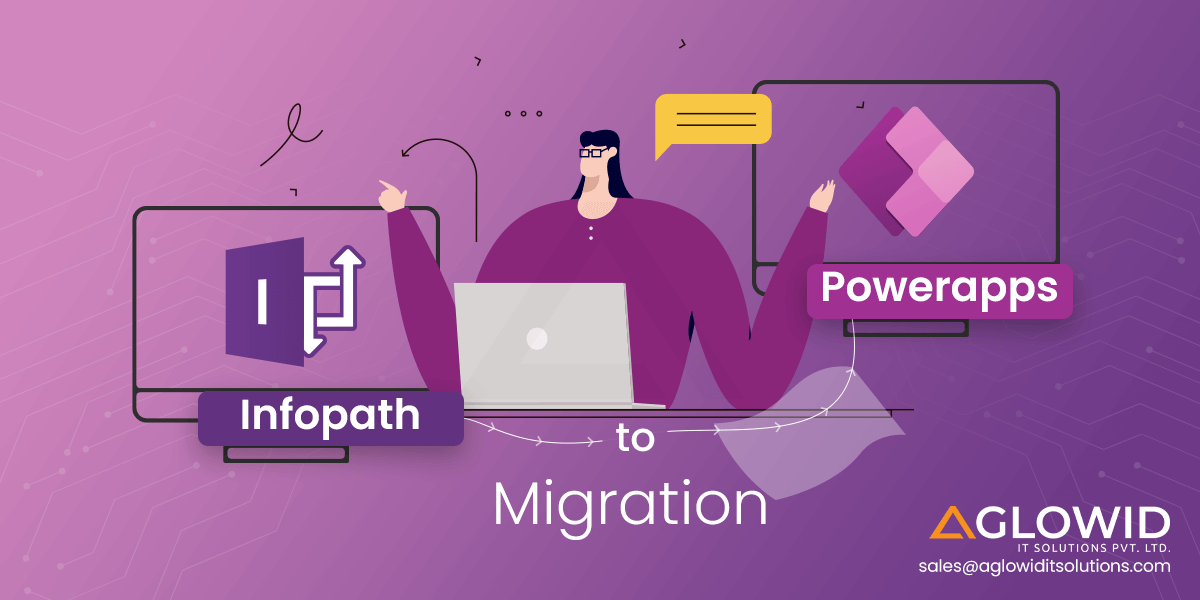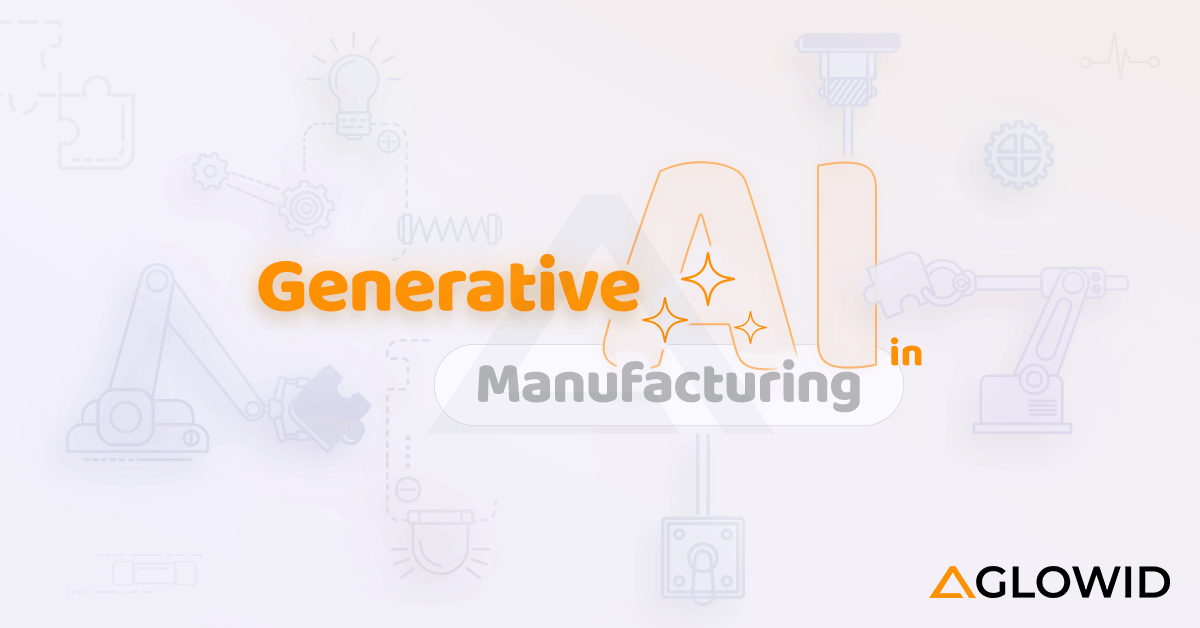Quick Summary:
Unlock the seamless transition from InfoPath to PowerApps with our step-by-step guide that covers – how, why, when, if, and what of making this decision and unlocking the dynamic capabilities of PowerApps to convert your forms for modern requirements.
If you are reading this blog, you are probably aware of Microsoft’s decision to migrate InfoPath to PowerApps and end support for InfoPath. The mainstream support has already ended, but many companies still need to transition to PowerApps, relying on the extensive support provided by Microsoft.
However, it might not be wise to hold on to the reigns of a dying platform that has gone obsolete compared to modern-day requirements. Today, we will discuss the importance of shifting from InfoPath Forms to PowerApps Forms, what the migration would look like, and what you need to keep in mind throughout the process.
When did Microsoft realize the need to shift from InfoPath to PowerApps?
Microsoft InfoPath was first released 2003 as part of the Microsoft Office 2003 family. It was a simple, user-friendly, and customer-centric forms tool for users to create, design, and distribute e-forms with structured data. InfoPath’s technology was very relevant for its time but couldn’t be modernized enough for the cloud and mobile app-led era that was upon us in the following years.
The mainstream support for Microsoft’s InfoPath Forms Services ended on July 13, 2021, with extended support for InfoPath 2010 till October 2020 and InfoPath 2013 till July 2026.
Realizing this mismatch, Microsoft started working on a modern forms solution, which we now know as PowerApps. The team at Microsoft started working on this project in 2015, to address the need of businesses to create custom apps quickly without following the traditional software development cycle. It was then officially launched in April 2016 as a public preview.
How to Migrate from InfoPath to Power Apps? – Step-by-Step Guide
We will cover a step-by-step guide for migrating your InfoPath Forms to PowerApps for readers who are certain about making the change but need clarification about how to proceed. If you are not yet convinced or confused about making the switch, you can click here to jump the subsequent sections, where we cover the limitations of InfoPath, the advantages of PowerApps, and when and why you should make the switch.
Now, without any further ado, let’s dive right into it:
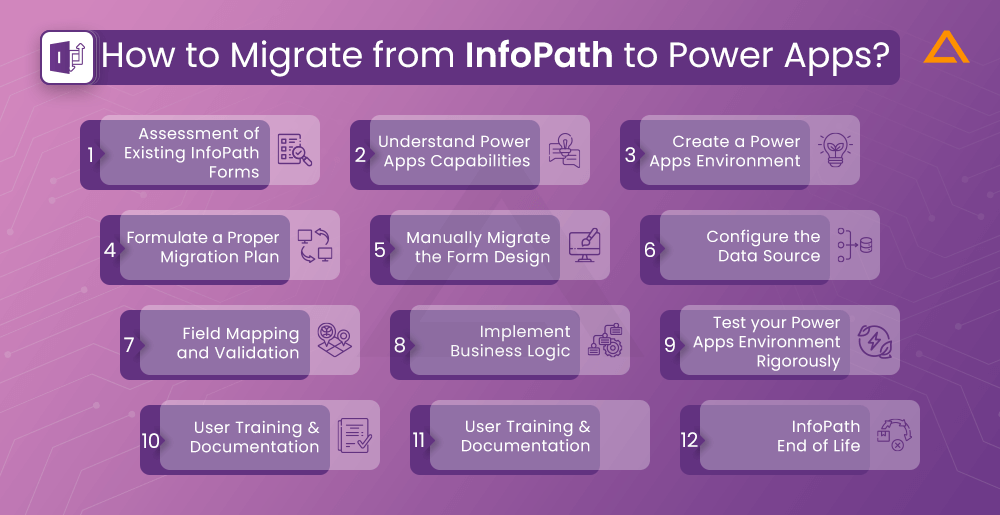
1. Assessment of Existing InfoPath Forms
Conduct a thorough review of your existing InfoPath Forms. Identify its structure, fields, and functionalities that need to be migrated. This evaluation will serve as the foundation for the subsequent steps in the migration process.
2. Understand Power Apps Capabilities
You should understand the platform and its extensive migration capabilities to Power Apps. Familiarize yourself with this new Power Platform’s ability to handle data, integrate with other MS services, and offer cross-platform compatibility. This knowledge will guide you in leveraging Power Apps to its full potential during migration.
3. Create a Power Apps Environment
Establish a dedicated Power Apps Environment for development and testing. This environment will provide an isolated space to build and refine your forms, ensuring a smooth transition without interference from other ongoing projects.
4. Formulate a Proper Migration Plan
Next, you need a detailed InfoPath to PowerApps migration plan in hand. Prioritize forms based on their criticality to your business processes. This plan will help you get a structured roadmap, ensuring the migration is organized and systematic.
5. Manually Migrate the Form Design
Begin the migration process by recreating the form design of your InfoPath forms in the Power Apps environment. You can make use of the drag-and-drop interface of Power Apps to replicate the structure seamlessly. Pay attention to the placements of your fields, sections, and any conditional formatting you have used in the original forms.
6. Configure the Data Source
Once you are done with the design aspect of the form, you need to connect the PowerApps form implementation to your data sources. Adjust data connections to seamlessly integrate with PowerApps to ensure their migrated forms maintain a consistent data flow. Validate the connections to ensure data integrity throughout the migration process.
7. Field Mapping and Validation
Carefully map fields from InfoPath to Power Apps to ensure a smooth transfer of your data. Implement validation rules for maintaining data accuracy and consistency. This is important to preserving the functionality of your forms and preventing data discrepancies.
8. Implement Business Logic
Replicate any business logic or custom code embedded in InfoPath forms to Power Apps. Leverage PowerApps functions and formulas for recreating the desired functionalities. Ensure the logic is translated accurately to maintainto maintain your business processes’ integrity.
9. Test your Power Apps Environment Rigorously
Conduct extensive testing on the migrated forms. Test scenarios like data entry, form submission, and other conditional logic. Identify and address any issues or discrepancies during the testing phase to ensure a seamless experience post-migration.
10. User Training & Documentation
Provide comprehensive training to users on the new Power Apps forms. You must create a detailed document highlighting all the major changes and improvements. This is crucial to ensure the end-users can adapt to your new forms and maximize the features offered by Power Apps.
11. Monitor & Gather Feedback
Monitor the performance of the migrated forms in a real-world environment. Gather feedback from users and other stakeholders to identify any post-migration issues or areas that could be improved. Promptly address and resolve any such concerns.
12. InfoPath End of Life
It is time to decommission InfoPath forms and communicate this transition to PowerApps to all relevant stakeholders to ensure the smooth discontinuation of the old platform.

Searching for IT Superstars?
We’re the AugMENTIONED Ones! 👀🌟”
Aglowid provides the best IT Staff Augmentation Solutions
Limitations and Challenges of InfoPath Forms
While InfoPath has been a reliable creation tool for many businesses for many years, it comes with certain limitations and challenges that would make you reconsider sticking to this platform even if Microsoft continued its support. Here are some of the most important ones you should be aware of –
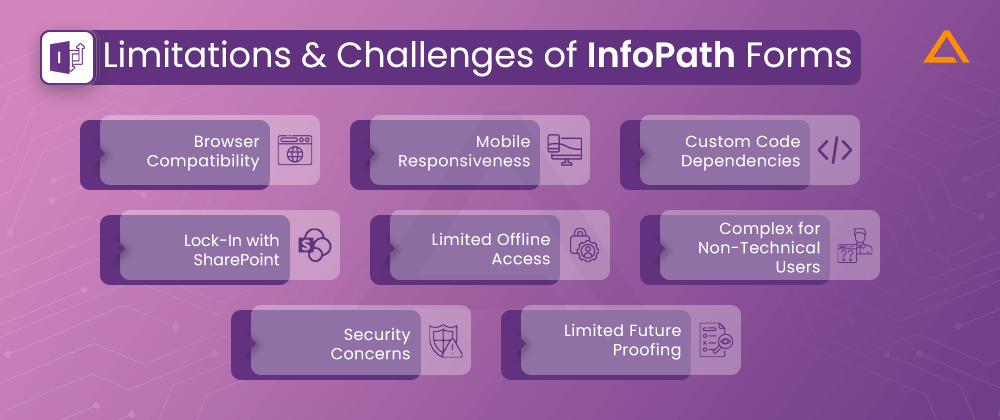
Browser Compatibility
InfoPath Forms face many challenges with cross-browser compatibility. Some features don’t render consistently across different browsers, which could lead to inconsistency in user experience & unintended functional flaws.
Mobile Responsiveness
InfoPath Forms came around back in 2006 and were never designed to be responsive for mobile devices. Users accessing forms on smartphones or tablets may encounter usability issues, requiring additional effort for mobile optimization.
Custom Code Dependencies
InfoPath Forms allows the inclusion of custom code to extend functionality. However, this reliance on custom code does possess its unique set of challenges during the migration or upgradation stages, as changes in technology can lead to functionality and compatibility mismatches of the custom code.
Lock-In with SharePoint
InfoPath is tightly integrated with SharePoint, and forms are stored in SharePoint document libraries. This can limit organizations that want more flexibility in storage and management outside the SharePoint ecosystem.
Limited Offline Access
InfoPath can be used offline, but the offline functionality is limited. Users might need a reliable internet connection to access or submit forms.
Complex for Non-Technical Users
Designing complex forms in InfoPath requires a certain level of technical expertise. Non-technical users might need assistance from IT professionals to create or modify forms.
Security Concerns
InfoPath Forms can be very prone to security hazards, especially if configured incorrectly. Since it’s an older technology with no active mainstream support, it needs modern security features in newer solutions like PowerApps.
Limited Future Proofing
As InfoPath is a deprecated technology, organizations are bound to face challenges in the long term when it comes to support, compatibility with newer systems, and also security requirements. Hence, delaying the migration of InfoPath forms to PowerApps forms is not wise.
Advantages of PowerApps Forms
PowerApps is not just a successor to InfoPath; it is a powerful and versatile platform many companies have widely adopted for their custom application and form creation requirements. Here are the key advantages of Power Apps:
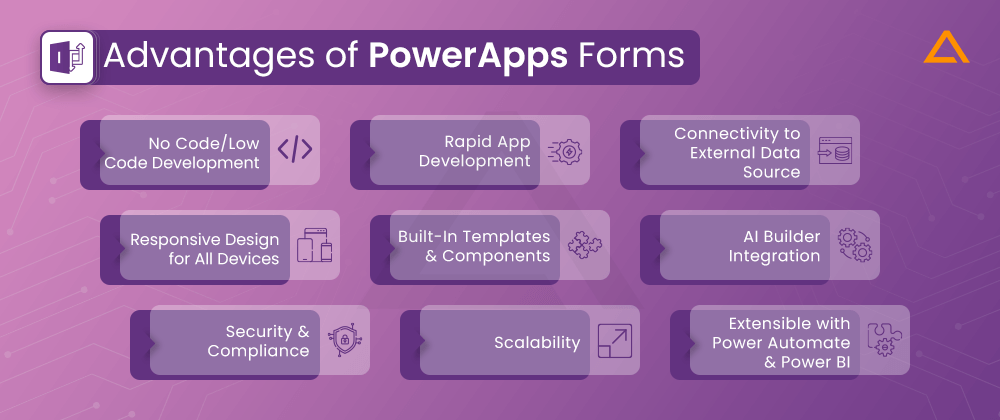
No Code/Low Code Development
Power Apps is designed with a no-code/low-code philosophy, enabling users with varying technical skills to create Power Apps without having extensive programming knowledge. This empowers the business users and reduces their reliability on having a full-time in-house app development team.
Rapid App Development
Power Apps facilitate rapid application development, allowing users to quickly prototype, build and deploy applications. This agility is one of the greatest assets in today’s time when organizations must develop efficient solutions swiftly to address their dynamic business requirements.
Connectivity to External Data Source
Power Apps were designed with scalability and modularity, unlike InfoPath, which is tightly knitted with SharePoint. You can integrate Power Apps with various external data sources, including SQL Server and Azure SQL database.
Responsive Design for All Devices
Power Apps provides responsive design capabilities that ensure your app works seamlessly across different screen sizes and devices. This responsiveness ensures a consistent user experience and accommodates users accessing apps on desktops, smartphones, tablets, or any smart device.
Built-In Templates and Components
Power Apps provides many pre-built templates and components that users can leverage as a starting point for their apps. This accelerates development by providing a foundation that can be further customized based on specific needs.
AI Builder Integration
AI Builder is integrated into Power Apps, which allows users to incorporate artificial intelligence capabilities into their applications. This includes features like image recognition, prediction, classification, and enhancing the functionality and intelligence of the apps.
Security & Compliance
Power Apps adheres to Microsoft’s robust security and compliance standards. It allows administrators to control access, permissions, and data governance, ensuring sensitive information gets handled securely.
Scalability
Power Apps is scalable to accommodate the needs of both small businesses and large enterprises. Organizations can start building simple apps and gradually move to more complex solutions as their needs evolve.
Extensible with Power Automate and Power BI
Power Apps integrates seamlessly with Power Automate for workflow automation and Power BI for business analytics. This integration allows users to create end-to-end solutions encompassing app development, automation, and data visualization.
Wrapping Up!
Migrating from InfoPath to PowerApps requires many configurations and meticulous and keen attention to detail. You want to ensure you replicate your forms to the finest detail and also migrate the data carefully. Leveraging PowerApps Consulting Services from a reliable Microsoft Partner is generally recommended.
